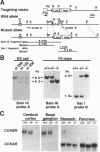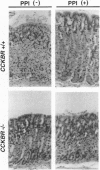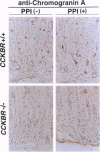Abstract
Many peptide hormone and neurotransmitter receptors belonging to the seven membrane-spanning G protein-coupled receptor family have been shown to transmit ligand-dependent mitogenic signals in vitro. However, the physiological roles of the mitogenic activity through G protein-coupled receptors in vivo remain to be elucidated. Here we have generated G protein-coupled cholecystokinin (CCK)-B/gastrin receptor deficient-mice by gene targeting. The homozygous mice showed a remarkable atrophy of the gastric mucosa macroscopically, even in the presence of severe hypergastrinemia. The atrophy was due to a decrease in parietal cells and chromogranin A-positive enterochromaffin-like cells expressing the H+,K(+)-ATPase and histidine decarboxylase genes, respectively. Oral administration of a proton pump inhibitor, omeprazole, which induced hypertrophy of the gastric mucosa with hypergastrinemia in wild-type littermates, did not eliminate the gastric atrophy of the homozygotes. These results clearly demonstrated that the G protein-coupled CCK-B/gastrin receptor is essential for the physiological as well as pathological proliferation of gastric mucosal cells in vivo.
Full text
PDF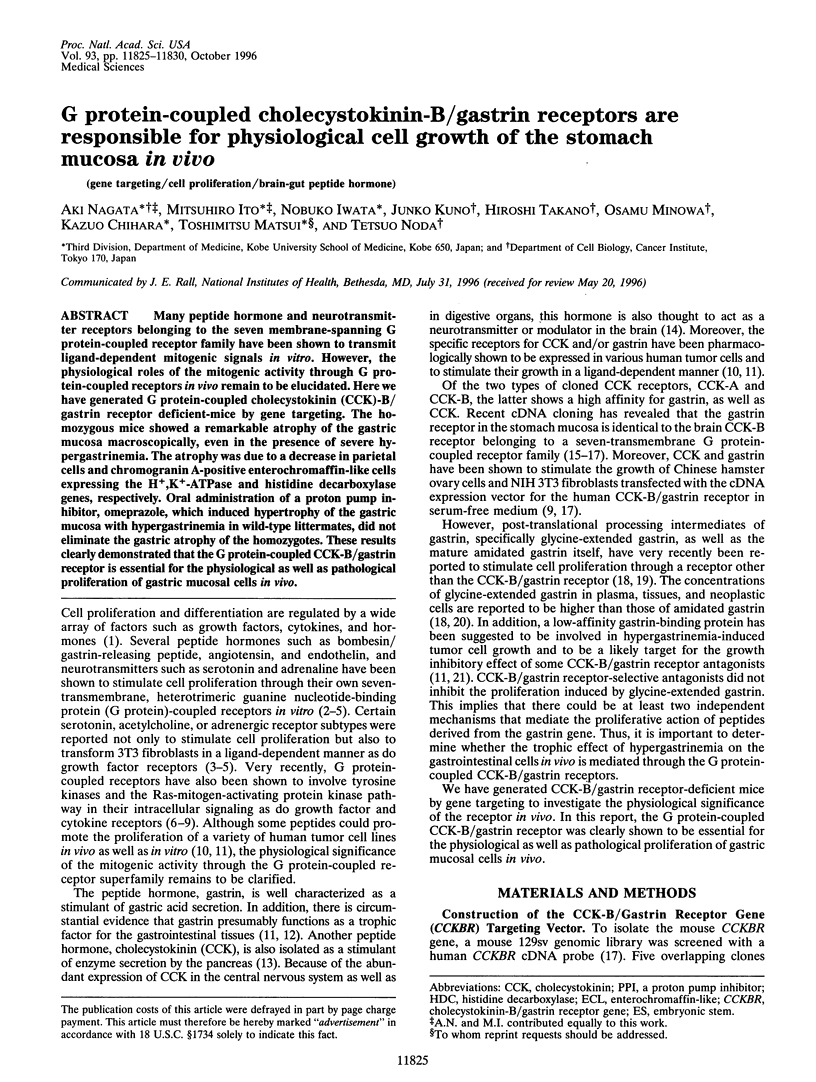

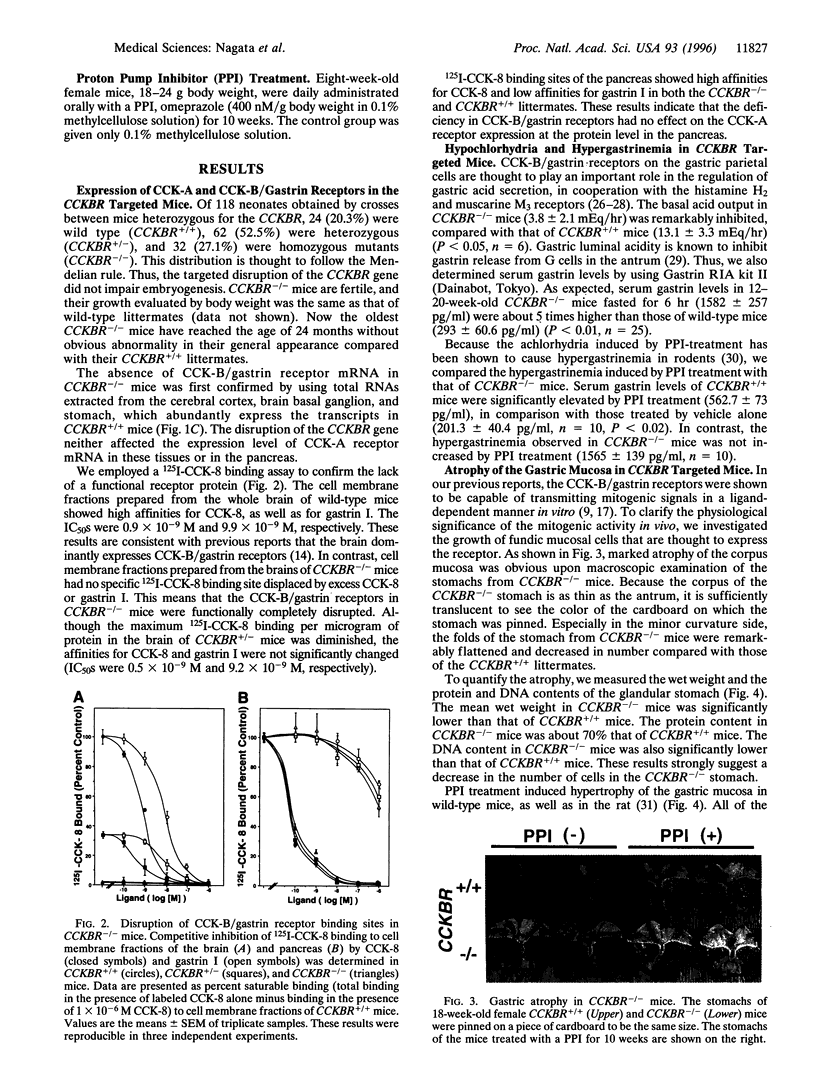
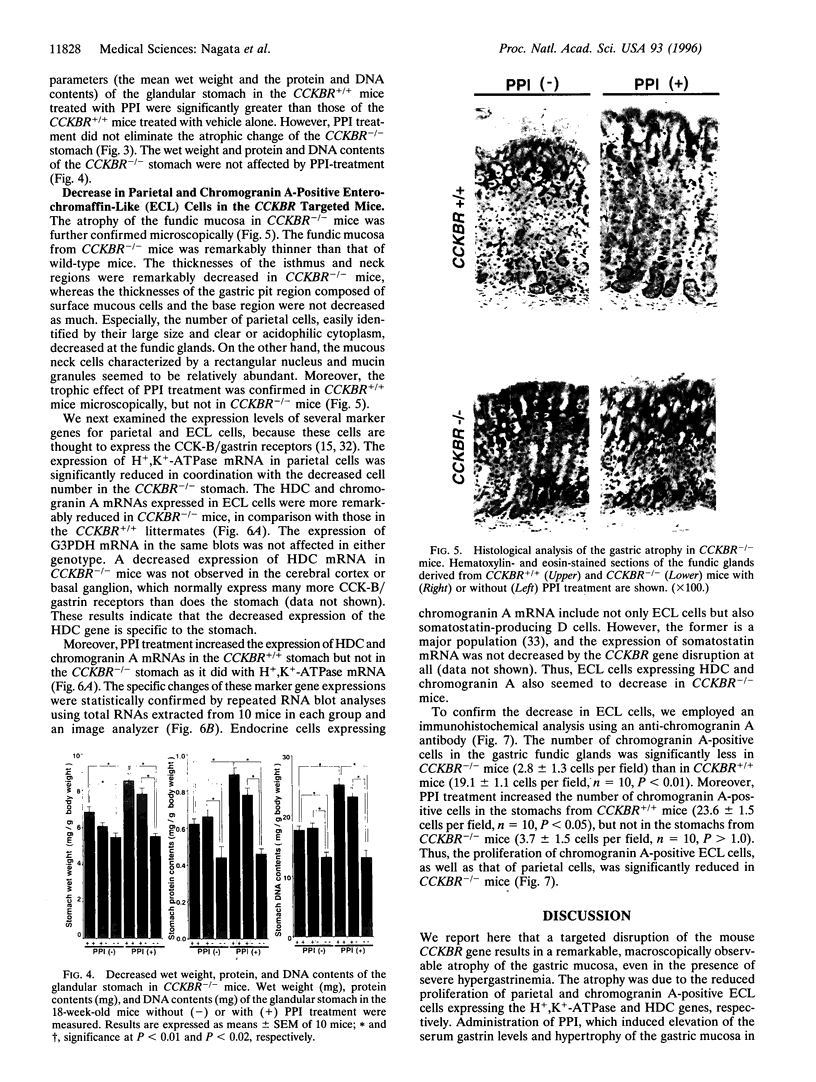
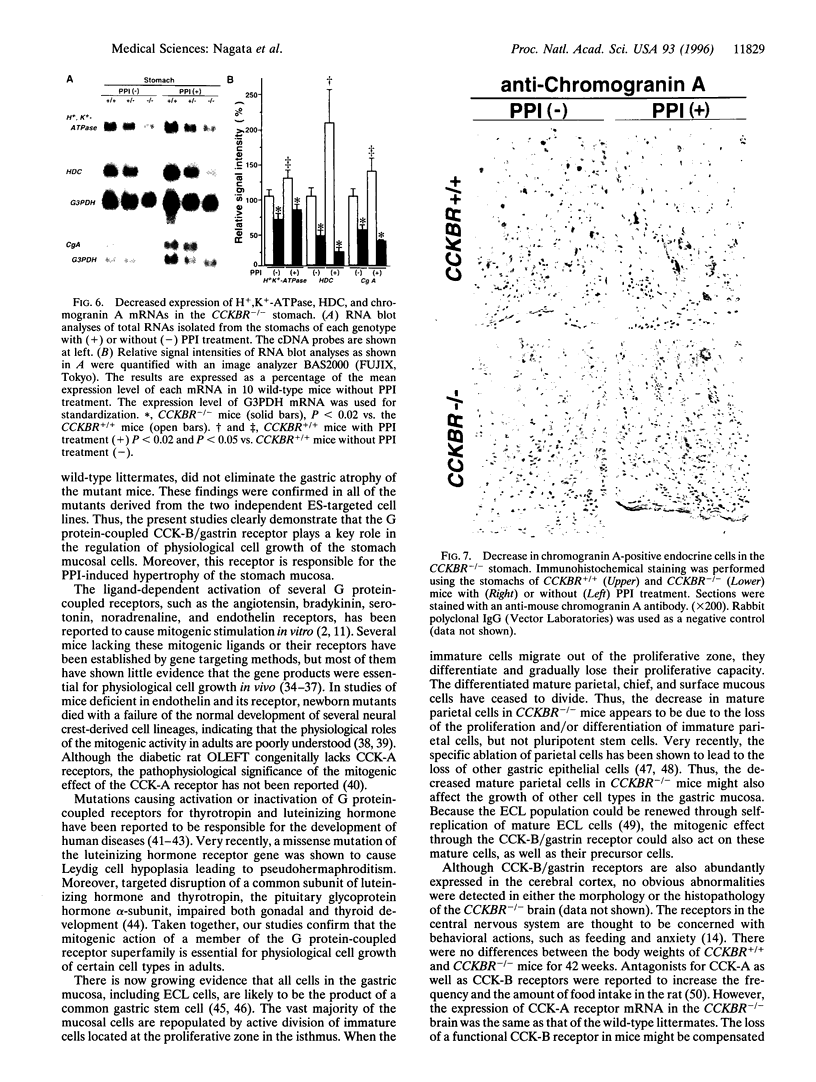
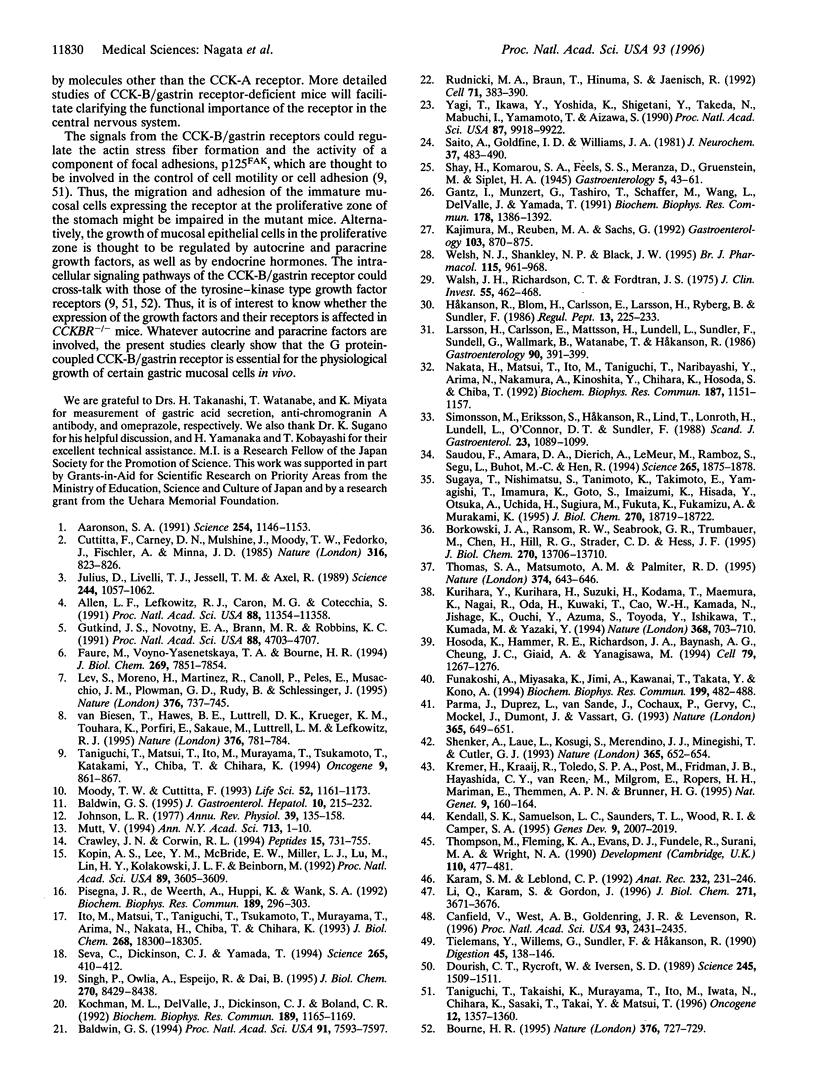
Images in this article
Selected References
These references are in PubMed. This may not be the complete list of references from this article.
- Aaronson S. A. Growth factors and cancer. Science. 1991 Nov 22;254(5035):1146–1153. doi: 10.1126/science.1659742. [DOI] [PubMed] [Google Scholar]
- Allen L. F., Lefkowitz R. J., Caron M. G., Cotecchia S. G-protein-coupled receptor genes as protooncogenes: constitutively activating mutation of the alpha 1B-adrenergic receptor enhances mitogenesis and tumorigenicity. Proc Natl Acad Sci U S A. 1991 Dec 15;88(24):11354–11358. doi: 10.1073/pnas.88.24.11354. [DOI] [PMC free article] [PubMed] [Google Scholar]
- Baldwin G. S. Antiproliferative gastrin/cholecystokinin receptor antagonists target the 78-kDa gastrin-binding protein. Proc Natl Acad Sci U S A. 1994 Aug 2;91(16):7593–7597. doi: 10.1073/pnas.91.16.7593. [DOI] [PMC free article] [PubMed] [Google Scholar]
- Baldwin G. S. The role of gastrin and cholecystokinin in normal and neoplastic gastrointestinal growth. J Gastroenterol Hepatol. 1995 Mar-Apr;10(2):215–232. doi: 10.1111/j.1440-1746.1995.tb01083.x. [DOI] [PubMed] [Google Scholar]
- Borkowski J. A., Ransom R. W., Seabrook G. R., Trumbauer M., Chen H., Hill R. G., Strader C. D., Hess J. F. Targeted disruption of a B2 bradykinin receptor gene in mice eliminates bradykinin action in smooth muscle and neurons. J Biol Chem. 1995 Jun 9;270(23):13706–13710. doi: 10.1074/jbc.270.23.13706. [DOI] [PubMed] [Google Scholar]
- Bourne H. R. Signal transduction. Team blue sees red. Nature. 1995 Aug 31;376(6543):727–729. doi: 10.1038/376727a0. [DOI] [PubMed] [Google Scholar]
- Canfield V., West A. B., Goldenring J. R., Levenson R. Genetic ablation of parietal cells in transgenic mice: a new model for analyzing cell lineage relationships in the gastric mucosa. Proc Natl Acad Sci U S A. 1996 Mar 19;93(6):2431–2435. doi: 10.1073/pnas.93.6.2431. [DOI] [PMC free article] [PubMed] [Google Scholar]
- Crawley J. N., Corwin R. L. Biological actions of cholecystokinin. Peptides. 1994;15(4):731–755. doi: 10.1016/0196-9781(94)90104-x. [DOI] [PubMed] [Google Scholar]
- Cuttitta F., Carney D. N., Mulshine J., Moody T. W., Fedorko J., Fischler A., Minna J. D. Bombesin-like peptides can function as autocrine growth factors in human small-cell lung cancer. 1985 Aug 29-Sep 4Nature. 316(6031):823–826. doi: 10.1038/316823a0. [DOI] [PubMed] [Google Scholar]
- Dourish C. T., Rycroft W., Iversen S. D. Postponement of satiety by blockade of brain cholecystokinin (CCK-B) receptors. Science. 1989 Sep 29;245(4925):1509–1511. doi: 10.1126/science.2781294. [DOI] [PubMed] [Google Scholar]
- Faure M., Voyno-Yasenetskaya T. A., Bourne H. R. cAMP and beta gamma subunits of heterotrimeric G proteins stimulate the mitogen-activated protein kinase pathway in COS-7 cells. J Biol Chem. 1994 Mar 18;269(11):7851–7854. [PubMed] [Google Scholar]
- Funakoshi A., Miyasaka K., Jimi A., Kawanai T., Takata Y., Kono A. Little or no expression of the cholecystokinin-A receptor gene in the pancreas of diabetic rats (Otsuka Long-Evans Tokushima Fatty = OLETF rats). Biochem Biophys Res Commun. 1994 Mar 15;199(2):482–488. doi: 10.1006/bbrc.1994.1254. [DOI] [PubMed] [Google Scholar]
- Gantz I., Munzert G., Tashiro T., Schäffer M., Wang L., DelValle J., Yamada T. Molecular cloning of the human histamine H2 receptor. Biochem Biophys Res Commun. 1991 Aug 15;178(3):1386–1392. doi: 10.1016/0006-291x(91)91047-g. [DOI] [PubMed] [Google Scholar]
- Gutkind J. S., Novotny E. A., Brann M. R., Robbins K. C. Muscarinic acetylcholine receptor subtypes as agonist-dependent oncogenes. Proc Natl Acad Sci U S A. 1991 Jun 1;88(11):4703–4707. doi: 10.1073/pnas.88.11.4703. [DOI] [PMC free article] [PubMed] [Google Scholar]
- Hosoda K., Hammer R. E., Richardson J. A., Baynash A. G., Cheung J. C., Giaid A., Yanagisawa M. Targeted and natural (piebald-lethal) mutations of endothelin-B receptor gene produce megacolon associated with spotted coat color in mice. Cell. 1994 Dec 30;79(7):1267–1276. doi: 10.1016/0092-8674(94)90017-5. [DOI] [PubMed] [Google Scholar]
- Håkanson R., Blom H., Carlsson E., Larsson H., Ryberg B., Sundler F. Hypergastrinaemia produces trophic effects in stomach but not in pancreas and intestines. Regul Pept. 1986 Feb;13(3-4):225–233. doi: 10.1016/0167-0115(86)90041-8. [DOI] [PubMed] [Google Scholar]
- Ito M., Matsui T., Taniguchi T., Tsukamoto T., Murayama T., Arima N., Nakata H., Chiba T., Chihara K. Functional characterization of a human brain cholecystokinin-B receptor. A trophic effect of cholecystokinin and gastrin. J Biol Chem. 1993 Aug 25;268(24):18300–18305. [PubMed] [Google Scholar]
- Johnson L. R. Gastrointestinal hormones and their functions. Annu Rev Physiol. 1977;39:135–158. doi: 10.1146/annurev.ph.39.030177.001031. [DOI] [PubMed] [Google Scholar]
- Julius D., Livelli T. J., Jessell T. M., Axel R. Ectopic expression of the serotonin 1c receptor and the triggering of malignant transformation. Science. 1989 Jun 2;244(4908):1057–1062. doi: 10.1126/science.2727693. [DOI] [PubMed] [Google Scholar]
- Kajimura M., Reuben M. A., Sachs G. The muscarinic receptor gene expressed in rabbit parietal cells is the m3 subtype. Gastroenterology. 1992 Sep;103(3):870–875. doi: 10.1016/0016-5085(92)90019-u. [DOI] [PubMed] [Google Scholar]
- Karam S. M., Leblond C. P. Identifying and counting epithelial cell types in the "corpus" of the mouse stomach. Anat Rec. 1992 Feb;232(2):231–246. doi: 10.1002/ar.1092320208. [DOI] [PubMed] [Google Scholar]
- Kendall S. K., Samuelson L. C., Saunders T. L., Wood R. I., Camper S. A. Targeted disruption of the pituitary glycoprotein hormone alpha-subunit produces hypogonadal and hypothyroid mice. Genes Dev. 1995 Aug 15;9(16):2007–2019. doi: 10.1101/gad.9.16.2007. [DOI] [PubMed] [Google Scholar]
- Kochman M. L., DelValle J., Dickinson C. J., Boland C. R. Post-translational processing of gastrin in neoplastic human colonic tissues. Biochem Biophys Res Commun. 1992 Dec 15;189(2):1165–1169. doi: 10.1016/0006-291x(92)92326-s. [DOI] [PubMed] [Google Scholar]
- Kopin A. S., Lee Y. M., McBride E. W., Miller L. J., Lu M., Lin H. Y., Kolakowski L. F., Jr, Beinborn M. Expression cloning and characterization of the canine parietal cell gastrin receptor. Proc Natl Acad Sci U S A. 1992 Apr 15;89(8):3605–3609. doi: 10.1073/pnas.89.8.3605. [DOI] [PMC free article] [PubMed] [Google Scholar]
- Kremer H., Kraaij R., Toledo S. P., Post M., Fridman J. B., Hayashida C. Y., van Reen M., Milgrom E., Ropers H. H., Mariman E. Male pseudohermaphroditism due to a homozygous missense mutation of the luteinizing hormone receptor gene. Nat Genet. 1995 Feb;9(2):160–164. doi: 10.1038/ng0295-160. [DOI] [PubMed] [Google Scholar]
- Kurihara Y., Kurihara H., Suzuki H., Kodama T., Maemura K., Nagai R., Oda H., Kuwaki T., Cao W. H., Kamada N. Elevated blood pressure and craniofacial abnormalities in mice deficient in endothelin-1. Nature. 1994 Apr 21;368(6473):703–710. doi: 10.1038/368703a0. [DOI] [PubMed] [Google Scholar]
- Larsson H., Carlsson E., Mattsson H., Lundell L., Sundler F., Sundell G., Wallmark B., Watanabe T., Håkanson R. Plasma gastrin and gastric enterochromaffinlike cell activation and proliferation. Studies with omeprazole and ranitidine in intact and antrectomized rats. Gastroenterology. 1986 Feb;90(2):391–399. doi: 10.1016/0016-5085(86)90938-8. [DOI] [PubMed] [Google Scholar]
- Lev S., Moreno H., Martinez R., Canoll P., Peles E., Musacchio J. M., Plowman G. D., Rudy B., Schlessinger J. Protein tyrosine kinase PYK2 involved in Ca(2+)-induced regulation of ion channel and MAP kinase functions. Nature. 1995 Aug 31;376(6543):737–745. doi: 10.1038/376737a0. [DOI] [PubMed] [Google Scholar]
- Li Q., Karam S. M., Gordon J. I. Diphtheria toxin-mediated ablation of parietal cells in the stomach of transgenic mice. J Biol Chem. 1996 Feb 16;271(7):3671–3676. [PubMed] [Google Scholar]
- Moody T. W., Cuttitta F. Growth factor and peptide receptors in small cell lung cancer. Life Sci. 1993;52(14):1161–1173. doi: 10.1016/0024-3205(93)90098-n. [DOI] [PubMed] [Google Scholar]
- Mutt V. Historical perspectives on cholecystokinin research. Ann N Y Acad Sci. 1994 Mar 23;713:1–10. doi: 10.1111/j.1749-6632.1994.tb44046.x. [DOI] [PubMed] [Google Scholar]
- Nakata H., Matsui T., Ito M., Taniguchi T., Naribayashi Y., Arima N., Nakamura A., Kinoshita Y., Chihara K., Hosoda S. Cloning and characterization of gastrin receptor from ECL carcinoid tumor of Mastomys natalensis. Biochem Biophys Res Commun. 1992 Sep 16;187(2):1151–1157. doi: 10.1016/0006-291x(92)91317-j. [DOI] [PubMed] [Google Scholar]
- Parma J., Duprez L., Van Sande J., Cochaux P., Gervy C., Mockel J., Dumont J., Vassart G. Somatic mutations in the thyrotropin receptor gene cause hyperfunctioning thyroid adenomas. Nature. 1993 Oct 14;365(6447):649–651. doi: 10.1038/365649a0. [DOI] [PubMed] [Google Scholar]
- Pisegna J. R., de Weerth A., Huppi K., Wank S. A. Molecular cloning of the human brain and gastric cholecystokinin receptor: structure, functional expression and chromosomal localization. Biochem Biophys Res Commun. 1992 Nov 30;189(1):296–303. doi: 10.1016/0006-291x(92)91557-7. [DOI] [PMC free article] [PubMed] [Google Scholar]
- Rudnicki M. A., Braun T., Hinuma S., Jaenisch R. Inactivation of MyoD in mice leads to up-regulation of the myogenic HLH gene Myf-5 and results in apparently normal muscle development. Cell. 1992 Oct 30;71(3):383–390. doi: 10.1016/0092-8674(92)90508-a. [DOI] [PubMed] [Google Scholar]
- Saito A., Goldfine I. D., Williams J. A. Characterization of receptors for cholecystokinin and related peptides in mouse cerebral cortex. J Neurochem. 1981 Aug;37(2):483–490. doi: 10.1111/j.1471-4159.1981.tb00481.x. [DOI] [PubMed] [Google Scholar]
- Saudou F., Amara D. A., Dierich A., LeMeur M., Ramboz S., Segu L., Buhot M. C., Hen R. Enhanced aggressive behavior in mice lacking 5-HT1B receptor. Science. 1994 Sep 23;265(5180):1875–1878. doi: 10.1126/science.8091214. [DOI] [PubMed] [Google Scholar]
- Seva C., Dickinson C. J., Yamada T. Growth-promoting effects of glycine-extended progastrin. Science. 1994 Jul 15;265(5170):410–412. doi: 10.1126/science.8023165. [DOI] [PubMed] [Google Scholar]
- Shenker A., Laue L., Kosugi S., Merendino J. J., Jr, Minegishi T., Cutler G. B., Jr A constitutively activating mutation of the luteinizing hormone receptor in familial male precocious puberty. Nature. 1993 Oct 14;365(6447):652–654. doi: 10.1038/365652a0. [DOI] [PubMed] [Google Scholar]
- Simonsson M., Eriksson S., Håkanson R., Lind T., Lönroth H., Lundell L., O'Connor D. T., Sundler F. Endocrine cells in the human oxyntic mucosa. A histochemical study. Scand J Gastroenterol. 1988 Nov;23(9):1089–1099. doi: 10.3109/00365528809090174. [DOI] [PubMed] [Google Scholar]
- Singh P., Owlia A., Espeijo R., Dai B. Novel gastrin receptors mediate mitogenic effects of gastrin and processing intermediates of gastrin on Swiss 3T3 fibroblasts. Absence of detectable cholecystokinin (CCK)-A and CCK-B receptors. J Biol Chem. 1995 Apr 14;270(15):8429–8438. doi: 10.1074/jbc.270.15.8429. [DOI] [PubMed] [Google Scholar]
- Sugaya T., Nishimatsu S., Tanimoto K., Takimoto E., Yamagishi T., Imamura K., Goto S., Imaizumi K., Hisada Y., Otsuka A. Angiotensin II type 1a receptor-deficient mice with hypotension and hyperreninemia. J Biol Chem. 1995 Aug 11;270(32):18719–18722. doi: 10.1074/jbc.270.32.18719. [DOI] [PubMed] [Google Scholar]
- Taniguchi T., Matsui T., Ito M., Murayama T., Tsukamoto T., Katakami Y., Chiba T., Chihara K. Cholecystokinin-B/gastrin receptor signaling pathway involves tyrosine phosphorylations of p125FAK and p42MAP. Oncogene. 1994 Mar;9(3):861–867. [PubMed] [Google Scholar]
- Taniguchi T., Takaishi K., Murayama T., Ito M., Iwata N., Chihara K., Sasaki T., Takai Y., Matsui T. Cholecystokinin-B/gastrin receptors mediate rapid formation of actin stress fibers. Oncogene. 1996 Mar 21;12(6):1357–1360. [PubMed] [Google Scholar]
- Thomas S. A., Matsumoto A. M., Palmiter R. D. Noradrenaline is essential for mouse fetal development. Nature. 1995 Apr 13;374(6523):643–646. doi: 10.1038/374643a0. [DOI] [PubMed] [Google Scholar]
- Thompson M., Fleming K. A., Evans D. J., Fundele R., Surani M. A., Wright N. A. Gastric endocrine cells share a clonal origin with other gut cell lineages. Development. 1990 Oct;110(2):477–481. doi: 10.1242/dev.110.2.477. [DOI] [PubMed] [Google Scholar]
- Tielemans Y., Willems G., Sundler F., Håkanson R. Self-replication of enterochromaffin-like cells in the mouse stomach. Digestion. 1990;45(3):138–146. doi: 10.1159/000200235. [DOI] [PubMed] [Google Scholar]
- Walsh J. H., Richardson C. T., Fordtran J. S. pH dependence of acid secretion and gastrin release in normal and ulcer subjects. J Clin Invest. 1975 Mar;55(3):462–468. doi: 10.1172/JCI107952. [DOI] [PMC free article] [PubMed] [Google Scholar]
- Welsh N. J., Shankley N. P., Black J. W. Application of a model to explore interspecies differences in acetylcholine M-receptor-stimulated gastric acid secretion. Br J Pharmacol. 1995 Jul;115(6):961–968. doi: 10.1111/j.1476-5381.1995.tb15904.x. [DOI] [PMC free article] [PubMed] [Google Scholar]
- Yagi T., Ikawa Y., Yoshida K., Shigetani Y., Takeda N., Mabuchi I., Yamamoto T., Aizawa S. Homologous recombination at c-fyn locus of mouse embryonic stem cells with use of diphtheria toxin A-fragment gene in negative selection. Proc Natl Acad Sci U S A. 1990 Dec;87(24):9918–9922. doi: 10.1073/pnas.87.24.9918. [DOI] [PMC free article] [PubMed] [Google Scholar]
- van Biesen T., Hawes B. E., Luttrell D. K., Krueger K. M., Touhara K., Porfiri E., Sakaue M., Luttrell L. M., Lefkowitz R. J. Receptor-tyrosine-kinase- and G beta gamma-mediated MAP kinase activation by a common signalling pathway. Nature. 1995 Aug 31;376(6543):781–784. doi: 10.1038/376781a0. [DOI] [PubMed] [Google Scholar]



